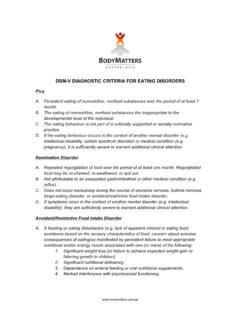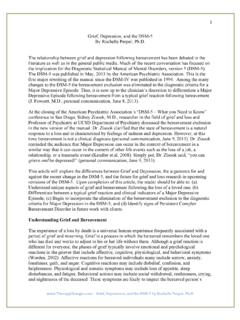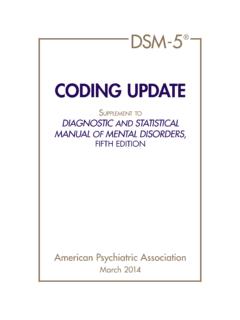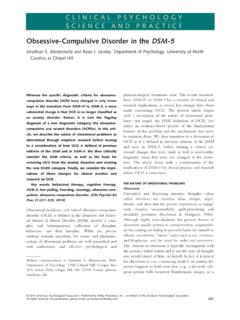Transcription of Psychologists Disorder With Implications for School DSM-5 ...
1 Full Terms & Conditions of access and use can be found by: [ ]Date: 02 November 2016, At: 12:39 International Journal of School & Educational PsychologyISSN: 2168-3603 (Print) 2168-3611 (Online) Journal homepage: Diagnostic criteria for autism SpectrumDisorder With Implications for SchoolPsychologistsAmy N. Esler & Lisa A. RubleTo cite this article: Amy N. Esler & Lisa A. Ruble (2015) DSM-5 Diagnostic criteria for AutismSpectrum Disorder With Implications for School Psychologists , International Journal of School & Educational Psychology, 3:1, 1-15, DOI: link to this article: online: 03 Feb your article to this journal Article views: 1604 View related articles View Crossmark dataARTICLESDSM-5 Diagnostic criteria for autism SpectrumDisorder With Implications for School PsychologistsAmy N.
2 EslerDepartment of Pediatrics, University of Minnesota, Minneapolis, Minnesota, USALisa A. RubleDepartment of Educational, School , and Consulting Psychology, University of Kentucky, Lexington, Kentucky, USAC hanges to the diagnosis of autism spectrum Disorder (ASD) within theDiagnostic andStatistical Manual of Mental Disorders, 5th edition ( DSM-5 ; American PsychiatricAssociation,2013) have important Implications for School Psychologists responsible forevaluating children with ASD, interpreting results to caregivers, and informing policy makersof needed revisions to eligibility criteria based on empirical understanding.
3 The primarypurpose of this review is to describe changes to the DSM-5 and the empirical evidence behindthe modifications. A secondary goal is to describe Implications for best practices in schoolevaluations for ASD. Given the concerns about the DSM-5 expressed by caregivers andindividuals with ASD during the revision process, School Psychologists who are aware of therationale for and Implications of the changes will be better positioned to assist local policymakers regarding diagnostic evaluations for ASD and address parental concerns regarding theevaluation process and service Implications for their.
4 autism , assessment, clinical diagnosis, practice issues, DSM-5 OVERVIEW OF NEW DIAGNOSTIC criteria FORAUTISM spectrum DISORDERTheDiagnostic and Statistical Manual of Mental Disorders,5th edition ( DSM-5 ; American Psychiatric Association[APA],2013) went into effect May 2013, and with it camesignificant revisions to the diagnosis of autism spectrumdisorder (ASD). These revisions have important implicationsfor School Psychologists responsible for evaluating childrenwith ASD, interpreting results to caregivers, and informingpolicy makers of needed revisions to eligibility criteria basedon empirical understanding.
5 Changes to the DSM-5 resultedfrom decades of research, and future research will beinfluenced by how ASD is now defined within the the process of decision making for ASD ineducational settings is distinct from that of a clinicaldiagnosis, the DSM informs how ASD is assessed withinpublic education systems. A large number of children withASD are identified for the first time through schoolevaluations (Wiggins, Baio, & Rice,2006). Many childrenwith ASD receive services beyond the School day ( ,private therapies, county support services), and coverage forthese services can require a medical diagnosis, leadingparents to seek additional evaluations in the evaluations that closely reflect the DSM-5 mayreduce duplication of assessments, which would helpfamilies access community services more readily, as wellas direct limited financial resources to treatment shouldbeaddressedto ,DepartmentofPediatrics, University of Minnesota, 717 Delaware St.
6 SE, Minneapolis,MN 55414, USA. Journal of School & Educational Psychology,3, 1 15, 2015 CopyrightqInternational School Psychology AssociationISSN 2168-3603 print/ISSN 2168-3611 many clinical evaluations include careful reviews ofpast assessments, School evaluations can significantlyinfluence diagnostic decisions and provide critical infor-mation regarding a child s behavior in natural social settingsthat is unavailable in clinical settings. Medical professionals,for example, are allotted less time for observation and directassessment than is achievable in schools and, thus, can missimportant nuances in a child s social primary purpose of this paper is to describe changes tothe DSM-5 and the empirical evidence behind themodifications.
7 A secondary goal is to describe implicationsof these changes for best practices in School evaluations forASD. Given the concerns about the DSM-5 that have beenexpressed by professionals, caregivers, and individuals withASD, School Psychologists who are aware of the rationale forand Implications of the changes will be better positioned toassist local policy makers regarding diagnostic evaluationsfor ASD and address parental concerns regarding theevaluation process and service Implications for their a Categorical to a Dimensional ApproachOne of the more significant changes to the DSM-5 was thecombining of the separate.
8 Categorical diagnoses of autisticdisorder, Asperger s Disorder , and pervasive developmentaldisorder, not otherwise specified (PDD-NOS) into onediagnosis: autism spectrum Disorder (ASD). While con-troversial, this change does not represent a stark departurefrom current practice. In 1991, Happe and Frith (1991)proposed the term autism spectrum disorders based onconcerns that the umbrella category of pervasive develop-mental Disorder (PDD) lacked clearly specified deficits, andtrying to fit individuals into one of three categories wasoften arbitrary, obscuring understanding of the heterogen-eity of ASD.
9 Most research to identify distinctive featuresof Asperger s, autism , and PDD-NOS failed to find anyreliable differences across PDD subtypes once IQ orlanguage were controlled. Distinctions among subtypeswere inconsistent over time and variable across clinicians( , Frith,2004; Howlin,2003;Lordetal.,2011;Macintosh & Dissanayake,2004; Ozonoff, South, & Miller,2000; Prior et al.,1998; Snow & Lecavalier,2011).Furthermore, subtypes had poor predictive validity of childoutcomes (Miller & Ozonoff,2000; Szatmari et al.,2009;Szatmari, Bryson, Boyle, Streiner, & Duku,2003) and thuswere uninformative for treatment planning.
10 Indeed, whilethe term was not adopted in the DSM-IV or ICD-10, autismspectrum disorders became commonly used (Williamset al.,2008).The DSM-5 represents a move toward dimensionaliza-tion of disorders ( , Kraemer,2007; Regier,2007). Thecategorical approach, represented by earlier versions of theDSM, involves determining whether a Disorder is present ornot. While categorization is necessary to some extent inestablishing a boundary between a Disorder and normalvariation in development, the development and course ofchildhood disorders are complex (Hudziak, Achenbach,Althoff, & Pine,2007).









